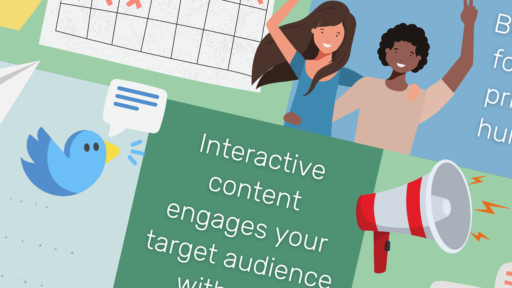Starting a business is a scary thought. And there’s a lot to consider. But more people than ever are ditching the 9-5 to become entrepreneurs.
Building a brand takes a ton of time and effort. But it’s doable with these 8 core pillars.
So, what makes a small business work? How can you be different from your competitors? Why should customers stick with you?
Well, your brand image should make your target audience pay attention. Because of how it looks and what you say. Businesses come and go. But a strong brand could be your legacy.
How to build a brand, not just a business
A brand gives your business an identity. It’s not just a money-maker any more. There’s value for people.
It’s what the most successful brands have in common:
- Nike – Empowered. Victory. Determination.
- Apple – Imagination. Innovation. Sleek.
- Starbucks – Warmth. Belonging. Welcoming.
- Coca-Cola – Happiness. Friendship. Fun.

Source: GIPHY
They all have unique brand personalities. They make their customers feel something. Because they provide an experience as well as a product. But like humans, a strong brand identity has to develop over time. So, you need a brand strategy that’ll get you there.
Here are the 8 core pillars of building a brand. Especially if it’s your first time:
- Brand building begins with your target audience
- A strong brand name
- Honing your brand story
- All content must represent your brand identity
- Choose a unique logo and aesthetic
- Consistency is key for brand awareness
- Get the word out on social media
- Authenticity should take priority
1. Brand building begins with your target audience
Your target market should be at the heart of your branding. So, first up. Who are these people? Why are they going to be choosing you over others?
Firstly, you need to pick your niche. And be specific about it. Who would your service or product best fit?
Do you make furniture? Technically, your potential customers could be anyone with a home. But what if you decided to make products for small spaces? Or those living in converted vans/buses?
If you’re too broad, there’s no USP (unique selling point). But find one, and you’ve struck gold.
Here are a few ways to identify your target market:
- Understand the problem your product/service solves
- Examine existing customers
- Create buyer personas
- Check out your competitors’ customers

Source: Cacoo
Brand positioning is your differentiation
Once you know your audience, you can start work on your brand positioning. This is what’ll set you apart from your competitors. Do some market research and ask yourself:
- Who is your competition?
- Where are they positioned in the market?
- Where are there gaps?
- What’s your value proposition? What makes you unique?
- How can you relay this to customers?

Source: Marketing91
This “positioning” is where your brand sits in customers’ minds. And some have totally mastered this.
You’ve heard of:
- Dumpster
- Bubble wrap
- Popsicle
All just generic items, right? Wrong. They’re actually all trademarked brand names. They’re positioned so strongly, they’re now the only brand in their niche worth knowing about.
Think you can get to Kleenex level too? Why the heck not.
2. Pick a strong brand name
The most obvious step of building a brand is your business name. It’ll be most people’s first interaction with your brand. So, it has to be:
- Memorable
- Easy to remember
- Unique
- Marketable
- Long-lasting
Some simple steps for picking your brand’s name are:
- Gather ideas from people you know
- Brainstorm words that vibe with your brand message (e.g. Nike – goddess of victory)
- Use words that are easy to say and spell
- Try abbreviations
- Make up a new word
If you’re really stuck, try AI name-generator sites. Like Namelix or Shopify’s. Here are a few suggestions from the keywords “dog collar”:

Source: Namelix
Once you’ve got some options, there are a few potential obstacles to be aware of:
- Trademarks
- Domain names
- Social media handles
Trademarks
So, you’ve thought of the perfect name. It suits your business perfectly. It’s definitely the one.
But you’re not the only one! Someone has already trademarked your brand name. So, they’ve beaten you to it. Because they’ve got exclusive use of it. Which means it’s back to the drawing board.
Trademarking means someone has legally registered specific words or symbols to rep their business. You can check any word or phrase on different sites depending on where you’re based. For example, the USA or UK.
Here are some for our previous keywords:

Yes, it’s annoying. But better to find out early than get a lawyer’s letter when you’re already established.
One you settle on one that isn’t trademarked, you might want to trademark it yourself.
Domain names
So, your brand name isn’t trademarked. Sweet! But don’t go printing those business cards just yet. Next up, the name of your website.
When people hear about your product, they’ll usually search 2 places. Google and social media. So, you need your site to rank top for your brand name keywords.
You can search for your URL idea directly. If it leads to a site, it’s in use already. Or you can use domain hosting sites to check availability. Try GoDaddy or Google’s own.

You can get creative too. Try using your tagline. Or making it a CTA. JustDoIt.com redirects to Nike’s site. Clever, huh?
Just keep it on-brand. And make sure it’s not easy to misspell. Once you’ve got one secured, you’re almost done.
Social media handles
Finally, your social handles. Now, these can be the same as your domain name. Or your brand’s. The main takeaway here is to try and get the same one across all social networks you’ll be on.
This step can be a bit of a pain as so many are taken. People can create accounts on Instagram and never use them. But they won’t be deleted. They’ll just sit in cyberspace.
If this is the case, you might need to change it up a bit. Maybe adding a word like “studio” or your location to the end.
Hey, even Taylor Swift can’t get her own name on Twitter.
What chance have we got?
3. What’s your brand story?
Loyal customers need an emotional connection to your brand. And this all begins with your brand story. Yes, this includes your tagline. But it goes deeper than that.
Your brand story includes:
- The purpose behind your business
- How you started
- Your ethos
- Your mission statement
- Where your company name came from
- How it all drives your business every day
Your marketing strategy is going to be based around this. So it’s super important. It’ll also be the starting point for future brand development.
You need to make your customer the focus of your story. What do they want or need? How can your brand help them achieve that?
For Tesla, it’s about merging tech and environmentalism:

Source: Ebaqdesign
For Rolex, it’s about abundance and status:

Source: Ebaqdesign
Of course, your story will be more detailed than this. But you need to be able to summarize it in a couple of lines too.
The power of storytelling
Storytelling creates emotional connection. Which leads to trust. And trust turns into revenue.
You shouldn’t be constantly bragging about how great your brand is. It’s about connecting with customers and making them part of your story.
Check out this TED Talk which explains it best:
A great brand story should:
- Evoke emotion
- Show how you’re solving a problem
- Focus on your audience
- Be genuine
If you can do all that, you’re off to a strong start.
4. All content must represent your brand identity
Content marketing is a must when building a brand online. It’s going to be your main marketing strategy. Because a) it’s free. And b) it can produce BIG results.
SEO (search engine optimization) helps your content rank highly in search engines. You want to be one of the first few options for select keywords. Because people (you and me) almost always click the top ones and forget the rest.
But the best content doesn’t promote your product. Because people don’t care about how great your brand says it is. They want you to show them. How is what you make going to enhance their lives?
Content marketing is all about solving problems. By doing this, you’ll build trust. But it can also be used for building brand awareness.
Red Bull’s supersonic freefall video doesn’t once mention their own product:
Sure, you see some branding. But the main focus is on their core values – adventure and extreme sport. It’s pretty much saying, “If you’re a risk-taker too, you’ll love our product”. Without actually saying anything.
The power of a unique brand voice
Everything you share on marketing channels is content. Even replying to Tweets or comments. So, what’s going to string it all together? Your brand voice.
This voice is the backbone of your brand identity. And it’s what’s going to make you instantly recognizable anywhere online.
Check out the differences between these 4 brands:
Some brands are sassy. Some are super informal. Others are knowledgeable. But what’s becoming clear is that humor is becoming a big part of content marketing. Especially on social media.
Even the more “serious” brands are taking part:
So, how can you get involved? Well, creating your own unique brand voice takes 5 steps:
1. Research your target audience
2. Complete some brand voice exercises
3. Create a brand voice template
4. Practice with the content you create and curate
5. Create brand voice guidelines to stay consistent
I’ve written a whole blog on that, so click the link above if you want more detail.
Something to consider, though. Different demographics will be on different channels. So, you may have to slightly tweak your brand voice into different marketing personas to appeal to each.
5. Choose a unique brand logo and aesthetic
This pillar focuses on the visual elements of your brand. From fonts to your color palette. It all plays a part. And it can be the difference between one that’s successful or not.
A high-end website is a must these days. And your social media channels will be based on its aesthetic. People just don’t trust sites that look outdated or low-quality.
The Big Ugly Website was created by designers to show what terrible UX looks like.

Source: The Big Ugly Website
This is an extreme example that’s meant to look bad. But would you buy from that site? I’m guessing no. So, how about a real-life example:

Source: Paradise Water
Too much info? Uh-huh. Low-quality images? Oh yeah. Would you trust this company to deliver your drinking water? Probably not.
Now, compare it to a site like Superlist:

Source: Superlist
Superlist is super clear. It’s vibrant. It’s to the point. It makes you want to be part of whatever they’re offering.
The effect of your logo design
Your company logo can be simple. Or it can be smart. And the basis of your whole aesthetic. The typography you choose could affect your fonts for the whole site. As well as any colors.
If you’re in eCommerce, it could be displayed on your merch. Your marketing campaigns could literally be based on it. So, choose wisely.
Let’s go back to Paradise Water’s logo:

At first glance, it looks like a casino logo. And if it didn’t have “drinking water” under it, I’d have no clue what it was. Also, what’s the image above? Is it supposed to be a waterfall? One thing’s for sure, it’s unclear. It clashes.
In some cases, a simple logo is better. Some of the world’s most famous brands use this tactic:

But your logo design can also be a chance to be really creative. Or pay someone to get creative for you. I love these 2 examples on Visme:


Source: Visme
Canva is a great tool for trying to create your own brand logo. Because there are loads of templates that make it easy.
But remember: great business owners don’t always make great graphic designers. If that’s you, search for local freelancers. Or use job sites like Upwork. Leave it to the professionals.
6. Consistency is key for brand awareness
Successful brand awareness means people instantly recognize your brand. But this can only happen if your target audience sees consistent messaging on all platforms.
And this doesn’t just mean your “look” stays the same. It means you’re delivering what you promise. Your core values never change.
Brand guidelines are essential as your business expands. As rhis means everyone working for you will be on the same page. These can be booklets or online documents.
Usually they include:
- Your company mission
- Brand voice examples
- A positioning statement
- Color palettes and aesthetic
- Typography
- Logo design
All big brands have them. And all small businesses should.
Brand guidelines examples
eCommerce brands use them to make sure all photography flows. Especially when they’re using different photographers. And constantly shooting new products.
Here’s Wolf Circus’ guidelines for their ads and promotional content:

Source: Issuu
Amazon has a ton of different vendors. So it’s got detailed guidelines about brand usage. For example, it doesn’t let any vendor use their branded buttons for ads:

Source: Amazon
They say it’s to stop customer confusion between the site and CTA ads. And it’s what you’d expect from such a customer-centric company.
Shazam emphasizes a consistent logo as part of theirs:

Source: Issuu
While Uber has a full site dedicated to brand building. With 9 core elements highlighted:
- Logo
- Color
- Composition
- Iconography
- Illustration
- Motion
- Photography
- Tone of voice
- Typography

But while guidelines keep you consistent, they don’t mean you can never change parts of your brand. Actually, the opposite. They give you a strong base to evolve from.
Rebranding is only possible when your target audience trusts your brand promise. So, build a solid reputation first. Then you can change things up.
7. Get the word out on social media
When building a brand, word-of-mouth is the most effective form of marketing. It’s directly responsible for 90% of all purchases. But what if no-one knows who you are yet?
Well, you’re gonna have to tell them yourself.
Social media engagement is something all businesses want. But not many are willing to work hard for it. If you want an audience to genuinely engage with your content, you need to engage back. You need to build rapport. Show you’re an active member of the community.
Find out which platforms your target audience uses. But don’t spread yourself too thin. Only create accounts where you know you’ll be able to regularly post. This is especially important if you’ve only got a small team. Or you’re a solopreneur.

Source: Hootsuite
Want some simple steps? Here’s how to build your brand on social media:
- Be where your target audience hangs out
- Fill in all details for all accounts
- Extend your site’s visual branding
- Post consistently
- Create and curate engaging content
- Join groups, lists, and pages
- Engage with your target audience wherever you can
- Study influencers in your niche
But can we take it further?
Use social media to direct to email
For startups, social media is especially important. Because there are so many free marketing channels to make use of. But whichever platforms you’re on, don’t forget this tip. Try to direct them all to one channel.
Email.
Facebook could shut down tomorrow and there goes your business. But building an email list will be one of the smartest things you could do. With email marketing, your list is there until they choose not to be. You’re not limited by algorithms or paid advertising.

Source: Oberlo
Social media is an important marketing channel. But don’t build your entire business on it. Use it wisely. And send your audience somewhere where you’ve got more control.
8. Authenticity should take priority
Today’s consumers aren’t dumb. They don’t just believe everything ads tell them anymore.

Source: Business Insider
Thanks to the internet, they’ve got power. The power to find out everything and anything about any company they want. 81% of retail shoppers research online before buying. So, you know they’re using it.
The world’s in a weird place right now. People are super conscious of how they spend their money. Potential customers need to trust you. They need to know your values are the same as theirs. If not, they’ll look elsewhere.
So, how can you build an authentic brand? Well, it’s pretty simple:
- Engage in conversations with your audience
- Feature user-generated content (UGC)
- Get your whole team involved
- Find and fix pain points
- Remain true to brand values
This last pillar really involves everything I’ve just talked about. It’s not just about being honest. It’s about being true to your brand identity. If you promise something, make sure you follow through.
Conclusion
For first-timers building a brand, this process can seem overwhelming. But break it down. You’ll see that each task is more than doable.
Plus, you don’t need to do it all yourself. Help is available at each stage. All you’ve got to do is ask those in the know.
To recap our 8 core pillars:
- Get to know your audience
- Choose a strong brand name
- Tell your brand story
- Use branded content marketing
- Pick a unique logo and look
- Be consistent
- Use social media marketing
- Stay authentic
Building a brand isn’t as hard as you’d think. It just needs solid research and a bit of creativity to back it up. If you can turn your business into a great story, you’re halfway there.
Do you think we missed out any core pillars of building a brand? Which do you think are the most important? Let us know below!





